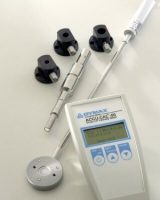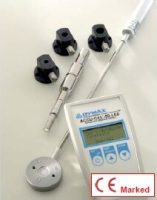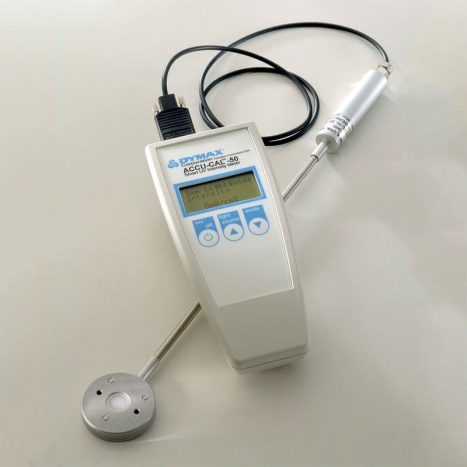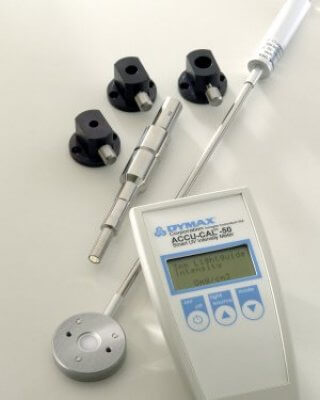Dymax ACCU-CAL™ 50 UV Radiometer Smart UV Intensity Meter
About Dymax ACCU-CAL™ 50 UV Radiometer
Consistent UV curing requires periodic monitoring of UV intensity or dose with a UV intensity meter. The Dymax ACCU-CAL 50 Radiometer is simple to operate and offers repeatable measurement of UV light.
There are two types of ACCU-CAL 50 radiometers:

ACCU-CAL 50 UV Intensity Meter
can measure UV light emitted from broad-spectrum lightguides (3mm, 5mm and 8mm), UV flood systems and UV conveyors. With a spectral sensitivity of 320nm to 390nm (UV-A), it measures intensities from 1mW/cm² to 40 W/cm².

ACCU-CAL 50-LED UV Intensity Meter
measures UV light emitted from LED UV equipment and has a spectral sensitivity of 350nm to 450nm.
A specially designed detector assembly protects the photo-sensor from the high temperatures sometimes associated with modern high intensity UV curing spot lamps, which can lead to inaccurate measurements. Fixtures are supplied which lock UV lamp lightguides into position over the sensor, giving accurate and repeatable measurements. The ACCU-CAL 50 features an easy-to-use instruction set with a simple, clear display and three button operation.
Features & Benefits
- Simple to operate
- Compact, hand-held, battery operated instrument
- Set screw locks lightguide in place for accuracy and repeatability
- PTB and NIST traceable
- Monitor and maintain a consistent light curing process
- Ensure a safe and operator friendly light curing process
- Measure transmission rates through substrates
Specifications
| Specification | ACCU-CAL 50 | ACCU-CAL 50-LED |
|---|---|---|
| Spectral sensitivity | 320nm to 390nm | 350nm to 450nm |
| Intensity range | 1mW/cm² to 40 W/cm² | 1mW/cm² to 40 W/cm² |
| Resolution | Intensity: 1mW/cm² to three significant digits Dose: 1mJ/cm² |
Intensity: 1mW/cm² to three significant digits Dose: 1mJ/cm² |
| Calibration period | 12 months | 12 months |
| Operating temperatures | Optometer (instrument): +5 to +40°C Detector (sensor): 120°C continuous, 200°C peak |
Optometer (instrument): +5 to +40°C Detector (sensor): 120°C continuous, 200°C peak |
| Measurement modes | Intensity: mW/cm² and W/cm² Peak intensity: mW/cm² and W/cm² Dose: J/cm² |
Intensity: mW/cm² Peak intensity: mW/cm² Dose: J/cm² |
| Light sources | Light guides (3, 5 & 8mm dia) Flood lamps Conveyors |
Light guides (3, 5 & 8mm dia) LED Flood Lamps |
| Power supply | 2 x AA batteries | 2 x AA batteries |
| Battery life | 250 hours (automatic shut off after 1 hour) | 250 hours (automatic shut off after 1 hour) |
| Detector (sensor) dimensions | Sensor aperture: 9mm Diameter: 37mm Thickness: 8mm Cable length: 1m |
Sensor aperture: 9mm Diameter: 37mm Thickness: 8mm Cable length: 1m |
| Optometer (instrument) dimensions | 120 x 65 x 23mm | 145 x 63 x 30mm |
Ordering Information
| Part number | Description |
|---|---|
| DYM39561 | ACCU-CAL 50 for flood lamps and conveyors. Complete radiometer (without lightguide adaptors). Includes storage/carrying case. |
| DYM39560 | ACCU-CAL 50 for spot and flood lamps and conveyors. Complete radiometer with lightguide adaptors (3, 5 & 8mm). Includes storage/carrying case. |
| DYM40505 | ACCU-CAL 50-LED for LED spot and flood units. Complete radiometer with lightguide adaptors (3, 5 & 8mm) and lightguide simulator. Includes storage/carrying case. |
| DYM40519 | ACCU-CAL 50-LED for LED Flood Units. Complete radiometer for LED flood and conveyor systems (without lightguide adaptors). Includes storage/carrying case. |
| DYM39554 | Flood to spot adaptor kit Includes three lightguide adaptors (3, 5 & 8mm) and a lightguide simulator |
| DYM39556 | Lightguide adaptor 3mm Fits 3mm lightguides (5mm OD) |
| DYM39557 | Lightguide adaptor 5mm Fits 5mm lightguides (7mm OD) |
| DYM39558 | Lightguide adaptor 8mm Fits 8mm lightguides (10mm OD) |
| DYM38408 | Lightguide simulator 5mm lightguide simulator with standard ‘D’ connector, suitable for DYMAX BlueWave lamps and others |
Let’s start by talking about your application
- Last updated: November 2022
- Version: 4.5
Statements, technical information and recommendations contained herein are based on tests we believe to be reliable but they are not to be construed in any manner as warrantees expressed or implied. The user shall determine the suitability of the product for his intended use and the user assumes all risk and liability whatsoever in connection therewith.




